Global Manager: Cross-Cultural Training Program at Bournemouth
VerifiedAdded on 2023/04/20
|18
|4559
|432
Report
AI Summary
This report provides a detailed analysis of a cross-cultural training (CCT) program designed for Mary Isaac, a senior project manager at Seagate Marine Construction (SMC) who is being assigned to Kobe, Japan. The report emphasizes the importance of CCT in today's globalized business environment, where cultural differences can lead to misunderstandings. It discusses the Mendenhall, Oddou, and Dunbar CCT training model, recommending the immersion approach for Mary due to the long-term nature of her assignment and the significant cultural differences between the UK and Japan. The report outlines the stages of CCT development, including identifying training objectives, determining the type of global project, analyzing specific training needs at organizational, individual, and assignment levels, establishing measurable goals, and developing and delivering the CCT program with methods like environmental briefing, cultural orientation, cultural assimilators, language training, and sensitivity training.
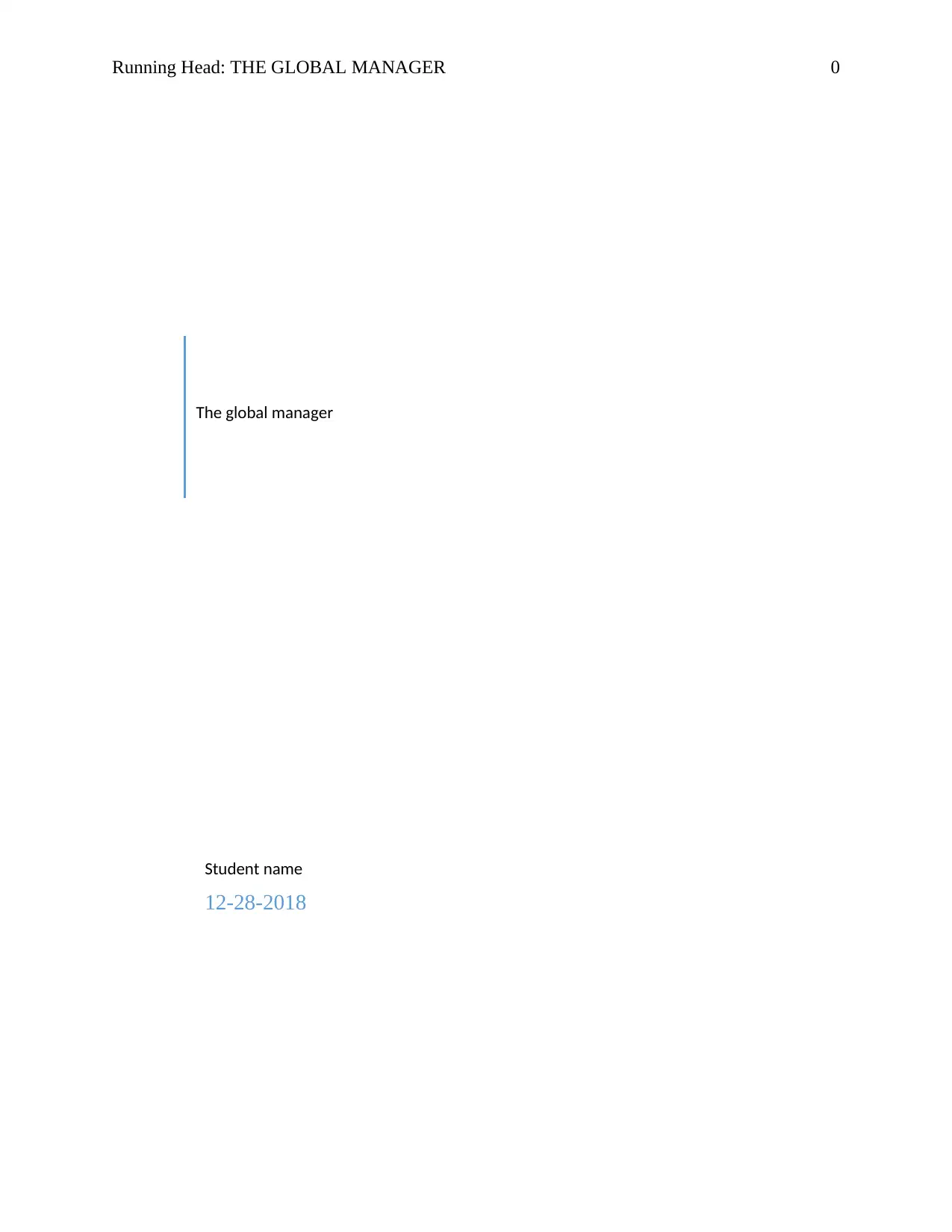
Running Head: THE GLOBAL MANAGER 0
The global manager
Student name
12-28-2018
The global manager
Student name
12-28-2018
Paraphrase This Document
Need a fresh take? Get an instant paraphrase of this document with our AI Paraphraser
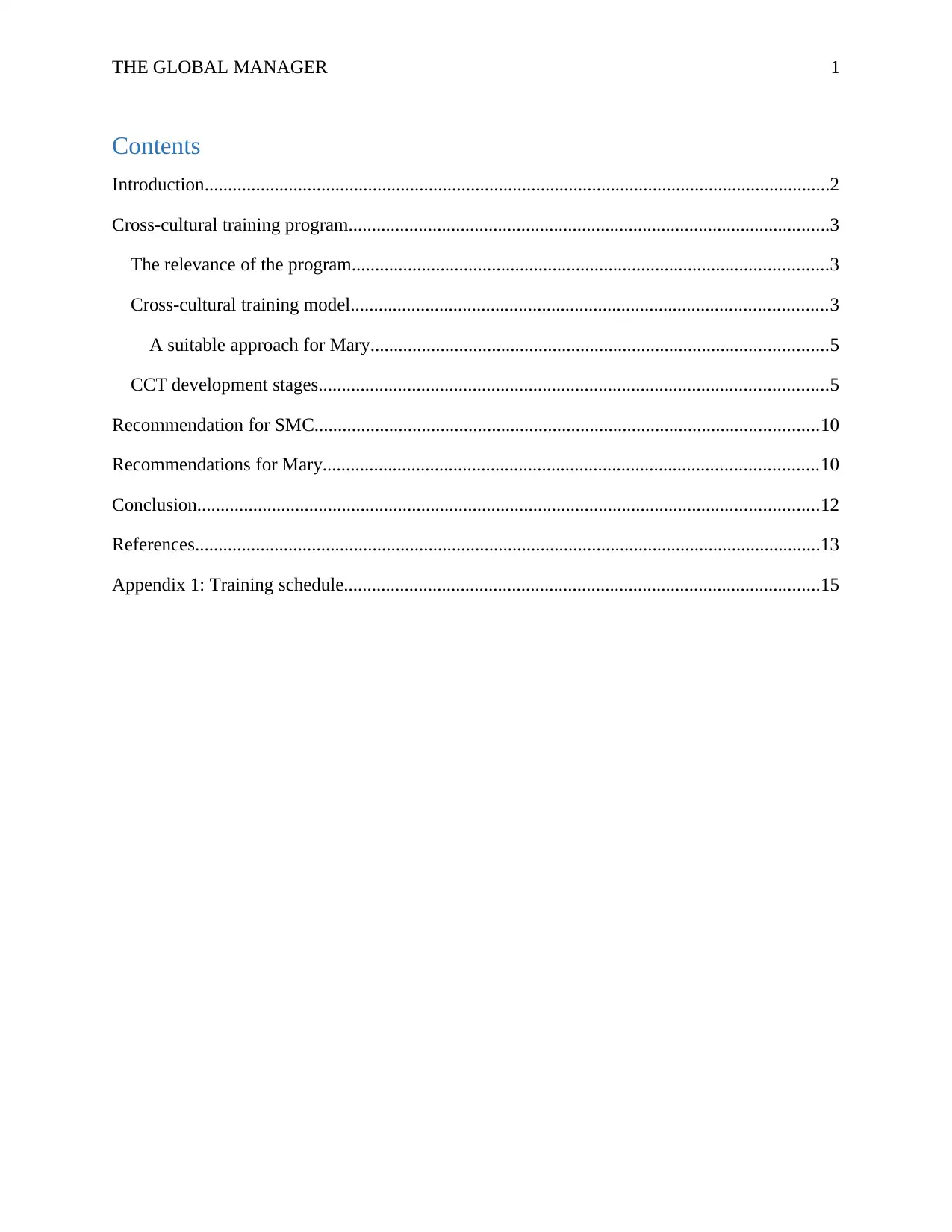
THE GLOBAL MANAGER 1
Contents
Introduction......................................................................................................................................2
Cross-cultural training program.......................................................................................................3
The relevance of the program......................................................................................................3
Cross-cultural training model......................................................................................................3
A suitable approach for Mary..................................................................................................5
CCT development stages.............................................................................................................5
Recommendation for SMC............................................................................................................10
Recommendations for Mary..........................................................................................................10
Conclusion.....................................................................................................................................12
References......................................................................................................................................13
Appendix 1: Training schedule......................................................................................................15
Contents
Introduction......................................................................................................................................2
Cross-cultural training program.......................................................................................................3
The relevance of the program......................................................................................................3
Cross-cultural training model......................................................................................................3
A suitable approach for Mary..................................................................................................5
CCT development stages.............................................................................................................5
Recommendation for SMC............................................................................................................10
Recommendations for Mary..........................................................................................................10
Conclusion.....................................................................................................................................12
References......................................................................................................................................13
Appendix 1: Training schedule......................................................................................................15
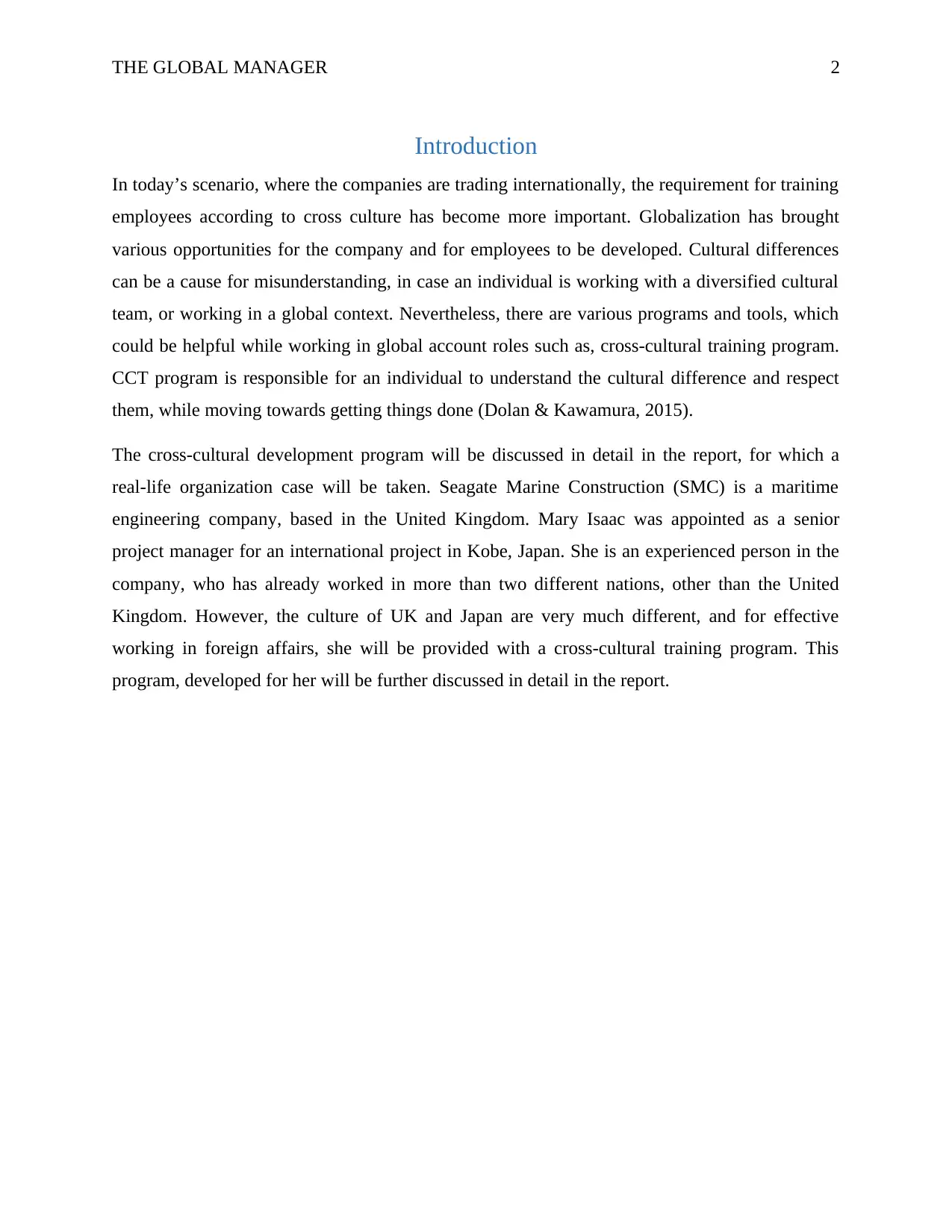
THE GLOBAL MANAGER 2
Introduction
In today’s scenario, where the companies are trading internationally, the requirement for training
employees according to cross culture has become more important. Globalization has brought
various opportunities for the company and for employees to be developed. Cultural differences
can be a cause for misunderstanding, in case an individual is working with a diversified cultural
team, or working in a global context. Nevertheless, there are various programs and tools, which
could be helpful while working in global account roles such as, cross-cultural training program.
CCT program is responsible for an individual to understand the cultural difference and respect
them, while moving towards getting things done (Dolan & Kawamura, 2015).
The cross-cultural development program will be discussed in detail in the report, for which a
real-life organization case will be taken. Seagate Marine Construction (SMC) is a maritime
engineering company, based in the United Kingdom. Mary Isaac was appointed as a senior
project manager for an international project in Kobe, Japan. She is an experienced person in the
company, who has already worked in more than two different nations, other than the United
Kingdom. However, the culture of UK and Japan are very much different, and for effective
working in foreign affairs, she will be provided with a cross-cultural training program. This
program, developed for her will be further discussed in detail in the report.
Introduction
In today’s scenario, where the companies are trading internationally, the requirement for training
employees according to cross culture has become more important. Globalization has brought
various opportunities for the company and for employees to be developed. Cultural differences
can be a cause for misunderstanding, in case an individual is working with a diversified cultural
team, or working in a global context. Nevertheless, there are various programs and tools, which
could be helpful while working in global account roles such as, cross-cultural training program.
CCT program is responsible for an individual to understand the cultural difference and respect
them, while moving towards getting things done (Dolan & Kawamura, 2015).
The cross-cultural development program will be discussed in detail in the report, for which a
real-life organization case will be taken. Seagate Marine Construction (SMC) is a maritime
engineering company, based in the United Kingdom. Mary Isaac was appointed as a senior
project manager for an international project in Kobe, Japan. She is an experienced person in the
company, who has already worked in more than two different nations, other than the United
Kingdom. However, the culture of UK and Japan are very much different, and for effective
working in foreign affairs, she will be provided with a cross-cultural training program. This
program, developed for her will be further discussed in detail in the report.
⊘ This is a preview!⊘
Do you want full access?
Subscribe today to unlock all pages.

Trusted by 1+ million students worldwide
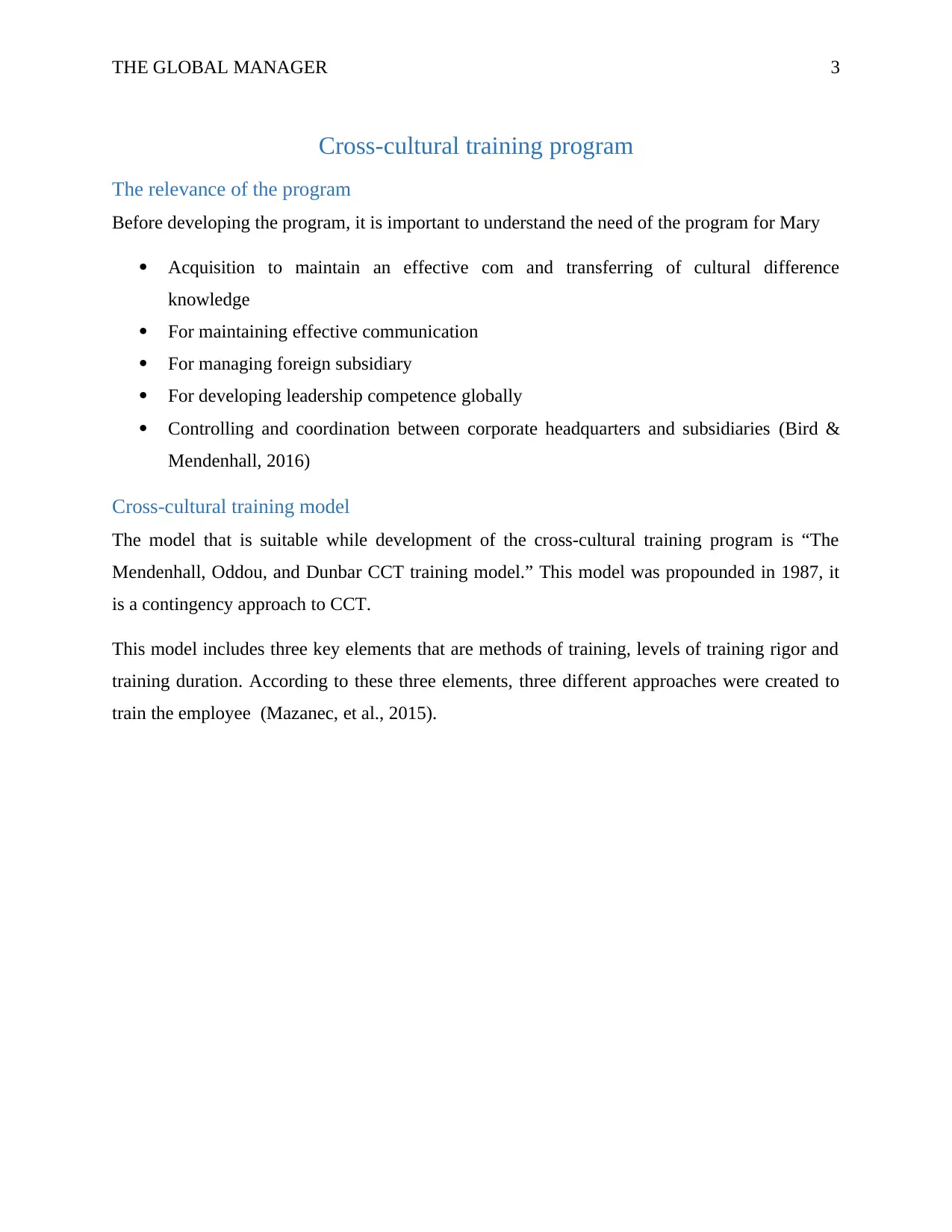
THE GLOBAL MANAGER 3
Cross-cultural training program
The relevance of the program
Before developing the program, it is important to understand the need of the program for Mary
Acquisition to maintain an effective com and transferring of cultural difference
knowledge
For maintaining effective communication
For managing foreign subsidiary
For developing leadership competence globally
Controlling and coordination between corporate headquarters and subsidiaries (Bird &
Mendenhall, 2016)
Cross-cultural training model
The model that is suitable while development of the cross-cultural training program is “The
Mendenhall, Oddou, and Dunbar CCT training model.” This model was propounded in 1987, it
is a contingency approach to CCT.
This model includes three key elements that are methods of training, levels of training rigor and
training duration. According to these three elements, three different approaches were created to
train the employee (Mazanec, et al., 2015).
Cross-cultural training program
The relevance of the program
Before developing the program, it is important to understand the need of the program for Mary
Acquisition to maintain an effective com and transferring of cultural difference
knowledge
For maintaining effective communication
For managing foreign subsidiary
For developing leadership competence globally
Controlling and coordination between corporate headquarters and subsidiaries (Bird &
Mendenhall, 2016)
Cross-cultural training model
The model that is suitable while development of the cross-cultural training program is “The
Mendenhall, Oddou, and Dunbar CCT training model.” This model was propounded in 1987, it
is a contingency approach to CCT.
This model includes three key elements that are methods of training, levels of training rigor and
training duration. According to these three elements, three different approaches were created to
train the employee (Mazanec, et al., 2015).
Paraphrase This Document
Need a fresh take? Get an instant paraphrase of this document with our AI Paraphraser
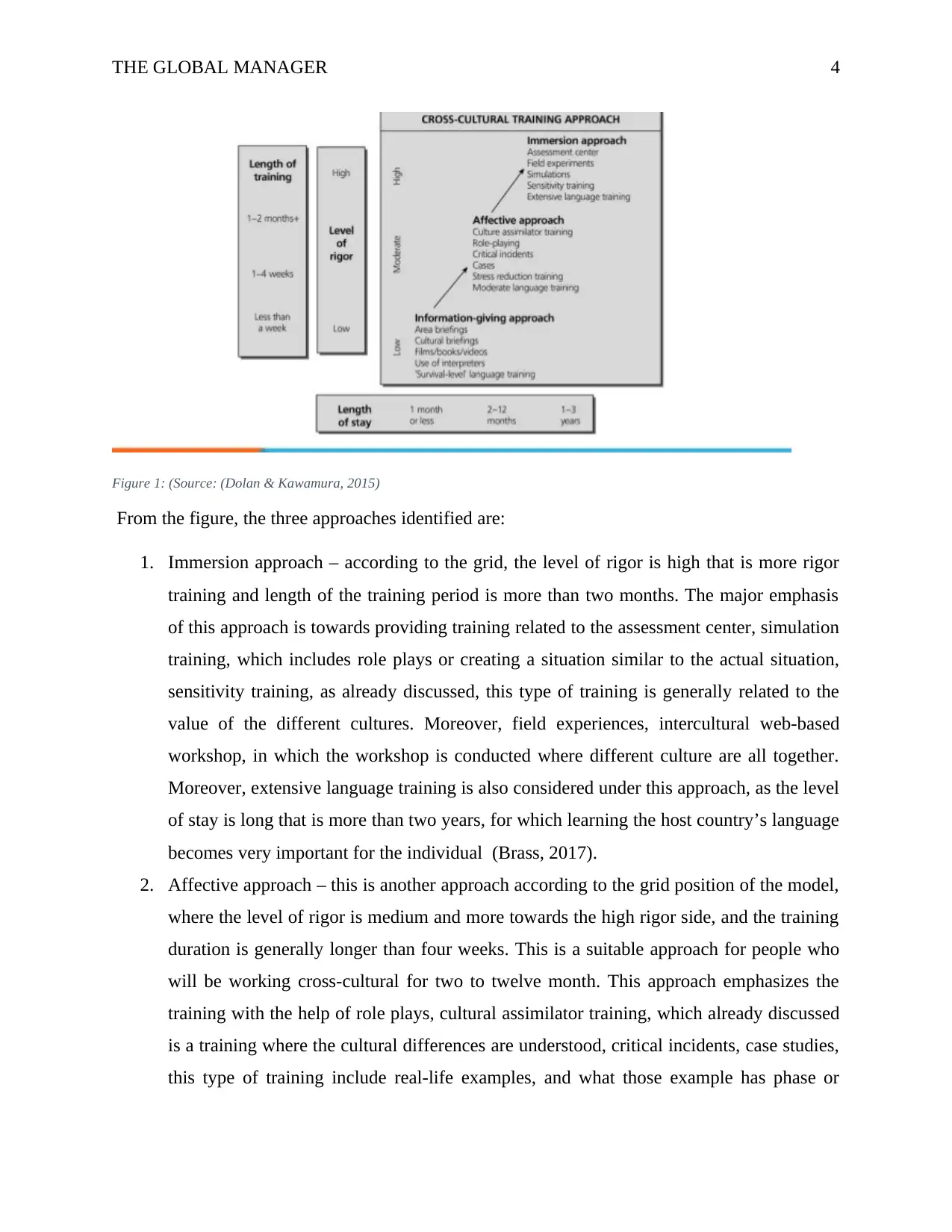
THE GLOBAL MANAGER 4
Figure 1: (Source: (Dolan & Kawamura, 2015)
From the figure, the three approaches identified are:
1. Immersion approach – according to the grid, the level of rigor is high that is more rigor
training and length of the training period is more than two months. The major emphasis
of this approach is towards providing training related to the assessment center, simulation
training, which includes role plays or creating a situation similar to the actual situation,
sensitivity training, as already discussed, this type of training is generally related to the
value of the different cultures. Moreover, field experiences, intercultural web-based
workshop, in which the workshop is conducted where different culture are all together.
Moreover, extensive language training is also considered under this approach, as the level
of stay is long that is more than two years, for which learning the host country’s language
becomes very important for the individual (Brass, 2017).
2. Affective approach – this is another approach according to the grid position of the model,
where the level of rigor is medium and more towards the high rigor side, and the training
duration is generally longer than four weeks. This is a suitable approach for people who
will be working cross-cultural for two to twelve month. This approach emphasizes the
training with the help of role plays, cultural assimilator training, which already discussed
is a training where the cultural differences are understood, critical incidents, case studies,
this type of training include real-life examples, and what those example has phase or
Figure 1: (Source: (Dolan & Kawamura, 2015)
From the figure, the three approaches identified are:
1. Immersion approach – according to the grid, the level of rigor is high that is more rigor
training and length of the training period is more than two months. The major emphasis
of this approach is towards providing training related to the assessment center, simulation
training, which includes role plays or creating a situation similar to the actual situation,
sensitivity training, as already discussed, this type of training is generally related to the
value of the different cultures. Moreover, field experiences, intercultural web-based
workshop, in which the workshop is conducted where different culture are all together.
Moreover, extensive language training is also considered under this approach, as the level
of stay is long that is more than two years, for which learning the host country’s language
becomes very important for the individual (Brass, 2017).
2. Affective approach – this is another approach according to the grid position of the model,
where the level of rigor is medium and more towards the high rigor side, and the training
duration is generally longer than four weeks. This is a suitable approach for people who
will be working cross-cultural for two to twelve month. This approach emphasizes the
training with the help of role plays, cultural assimilator training, which already discussed
is a training where the cultural differences are understood, critical incidents, case studies,
this type of training include real-life examples, and what those example has phase or
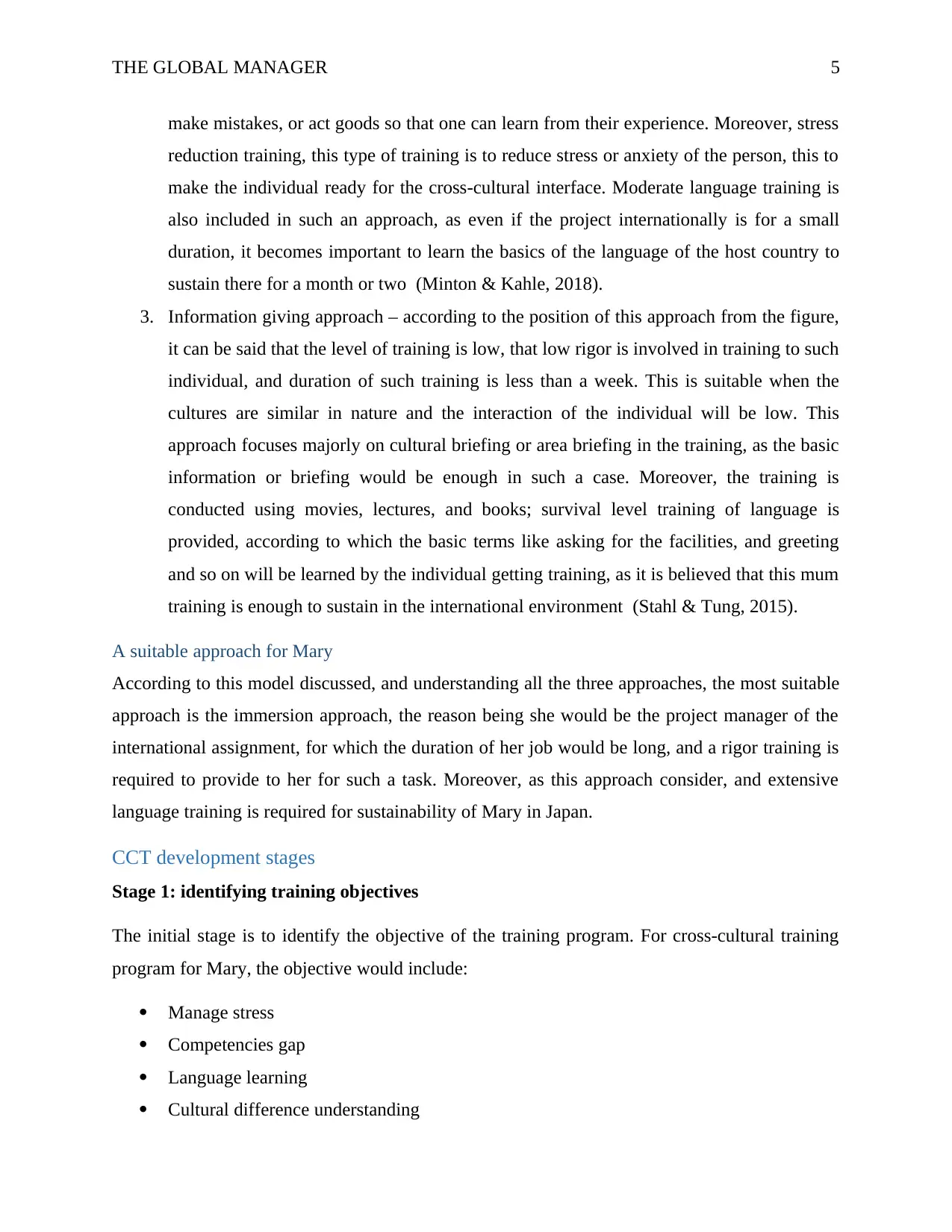
THE GLOBAL MANAGER 5
make mistakes, or act goods so that one can learn from their experience. Moreover, stress
reduction training, this type of training is to reduce stress or anxiety of the person, this to
make the individual ready for the cross-cultural interface. Moderate language training is
also included in such an approach, as even if the project internationally is for a small
duration, it becomes important to learn the basics of the language of the host country to
sustain there for a month or two (Minton & Kahle, 2018).
3. Information giving approach – according to the position of this approach from the figure,
it can be said that the level of training is low, that low rigor is involved in training to such
individual, and duration of such training is less than a week. This is suitable when the
cultures are similar in nature and the interaction of the individual will be low. This
approach focuses majorly on cultural briefing or area briefing in the training, as the basic
information or briefing would be enough in such a case. Moreover, the training is
conducted using movies, lectures, and books; survival level training of language is
provided, according to which the basic terms like asking for the facilities, and greeting
and so on will be learned by the individual getting training, as it is believed that this mum
training is enough to sustain in the international environment (Stahl & Tung, 2015).
A suitable approach for Mary
According to this model discussed, and understanding all the three approaches, the most suitable
approach is the immersion approach, the reason being she would be the project manager of the
international assignment, for which the duration of her job would be long, and a rigor training is
required to provide to her for such a task. Moreover, as this approach consider, and extensive
language training is required for sustainability of Mary in Japan.
CCT development stages
Stage 1: identifying training objectives
The initial stage is to identify the objective of the training program. For cross-cultural training
program for Mary, the objective would include:
Manage stress
Competencies gap
Language learning
Cultural difference understanding
make mistakes, or act goods so that one can learn from their experience. Moreover, stress
reduction training, this type of training is to reduce stress or anxiety of the person, this to
make the individual ready for the cross-cultural interface. Moderate language training is
also included in such an approach, as even if the project internationally is for a small
duration, it becomes important to learn the basics of the language of the host country to
sustain there for a month or two (Minton & Kahle, 2018).
3. Information giving approach – according to the position of this approach from the figure,
it can be said that the level of training is low, that low rigor is involved in training to such
individual, and duration of such training is less than a week. This is suitable when the
cultures are similar in nature and the interaction of the individual will be low. This
approach focuses majorly on cultural briefing or area briefing in the training, as the basic
information or briefing would be enough in such a case. Moreover, the training is
conducted using movies, lectures, and books; survival level training of language is
provided, according to which the basic terms like asking for the facilities, and greeting
and so on will be learned by the individual getting training, as it is believed that this mum
training is enough to sustain in the international environment (Stahl & Tung, 2015).
A suitable approach for Mary
According to this model discussed, and understanding all the three approaches, the most suitable
approach is the immersion approach, the reason being she would be the project manager of the
international assignment, for which the duration of her job would be long, and a rigor training is
required to provide to her for such a task. Moreover, as this approach consider, and extensive
language training is required for sustainability of Mary in Japan.
CCT development stages
Stage 1: identifying training objectives
The initial stage is to identify the objective of the training program. For cross-cultural training
program for Mary, the objective would include:
Manage stress
Competencies gap
Language learning
Cultural difference understanding
⊘ This is a preview!⊘
Do you want full access?
Subscribe today to unlock all pages.

Trusted by 1+ million students worldwide
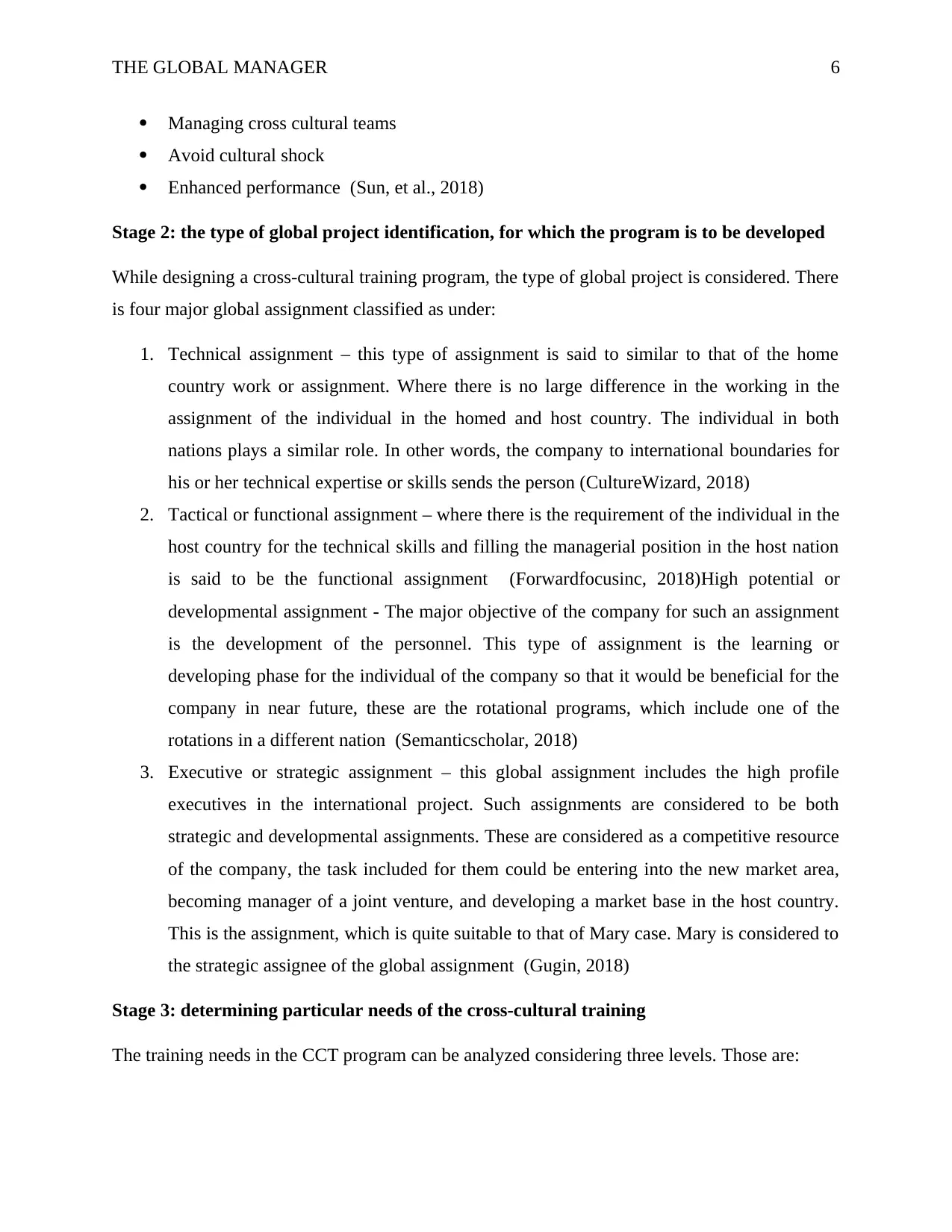
THE GLOBAL MANAGER 6
Managing cross cultural teams
Avoid cultural shock
Enhanced performance (Sun, et al., 2018)
Stage 2: the type of global project identification, for which the program is to be developed
While designing a cross-cultural training program, the type of global project is considered. There
is four major global assignment classified as under:
1. Technical assignment – this type of assignment is said to similar to that of the home
country work or assignment. Where there is no large difference in the working in the
assignment of the individual in the homed and host country. The individual in both
nations plays a similar role. In other words, the company to international boundaries for
his or her technical expertise or skills sends the person (CultureWizard, 2018)
2. Tactical or functional assignment – where there is the requirement of the individual in the
host country for the technical skills and filling the managerial position in the host nation
is said to be the functional assignment (Forwardfocusinc, 2018)High potential or
developmental assignment - The major objective of the company for such an assignment
is the development of the personnel. This type of assignment is the learning or
developing phase for the individual of the company so that it would be beneficial for the
company in near future, these are the rotational programs, which include one of the
rotations in a different nation (Semanticscholar, 2018)
3. Executive or strategic assignment – this global assignment includes the high profile
executives in the international project. Such assignments are considered to be both
strategic and developmental assignments. These are considered as a competitive resource
of the company, the task included for them could be entering into the new market area,
becoming manager of a joint venture, and developing a market base in the host country.
This is the assignment, which is quite suitable to that of Mary case. Mary is considered to
the strategic assignee of the global assignment (Gugin, 2018)
Stage 3: determining particular needs of the cross-cultural training
The training needs in the CCT program can be analyzed considering three levels. Those are:
Managing cross cultural teams
Avoid cultural shock
Enhanced performance (Sun, et al., 2018)
Stage 2: the type of global project identification, for which the program is to be developed
While designing a cross-cultural training program, the type of global project is considered. There
is four major global assignment classified as under:
1. Technical assignment – this type of assignment is said to similar to that of the home
country work or assignment. Where there is no large difference in the working in the
assignment of the individual in the homed and host country. The individual in both
nations plays a similar role. In other words, the company to international boundaries for
his or her technical expertise or skills sends the person (CultureWizard, 2018)
2. Tactical or functional assignment – where there is the requirement of the individual in the
host country for the technical skills and filling the managerial position in the host nation
is said to be the functional assignment (Forwardfocusinc, 2018)High potential or
developmental assignment - The major objective of the company for such an assignment
is the development of the personnel. This type of assignment is the learning or
developing phase for the individual of the company so that it would be beneficial for the
company in near future, these are the rotational programs, which include one of the
rotations in a different nation (Semanticscholar, 2018)
3. Executive or strategic assignment – this global assignment includes the high profile
executives in the international project. Such assignments are considered to be both
strategic and developmental assignments. These are considered as a competitive resource
of the company, the task included for them could be entering into the new market area,
becoming manager of a joint venture, and developing a market base in the host country.
This is the assignment, which is quite suitable to that of Mary case. Mary is considered to
the strategic assignee of the global assignment (Gugin, 2018)
Stage 3: determining particular needs of the cross-cultural training
The training needs in the CCT program can be analyzed considering three levels. Those are:
Paraphrase This Document
Need a fresh take? Get an instant paraphrase of this document with our AI Paraphraser
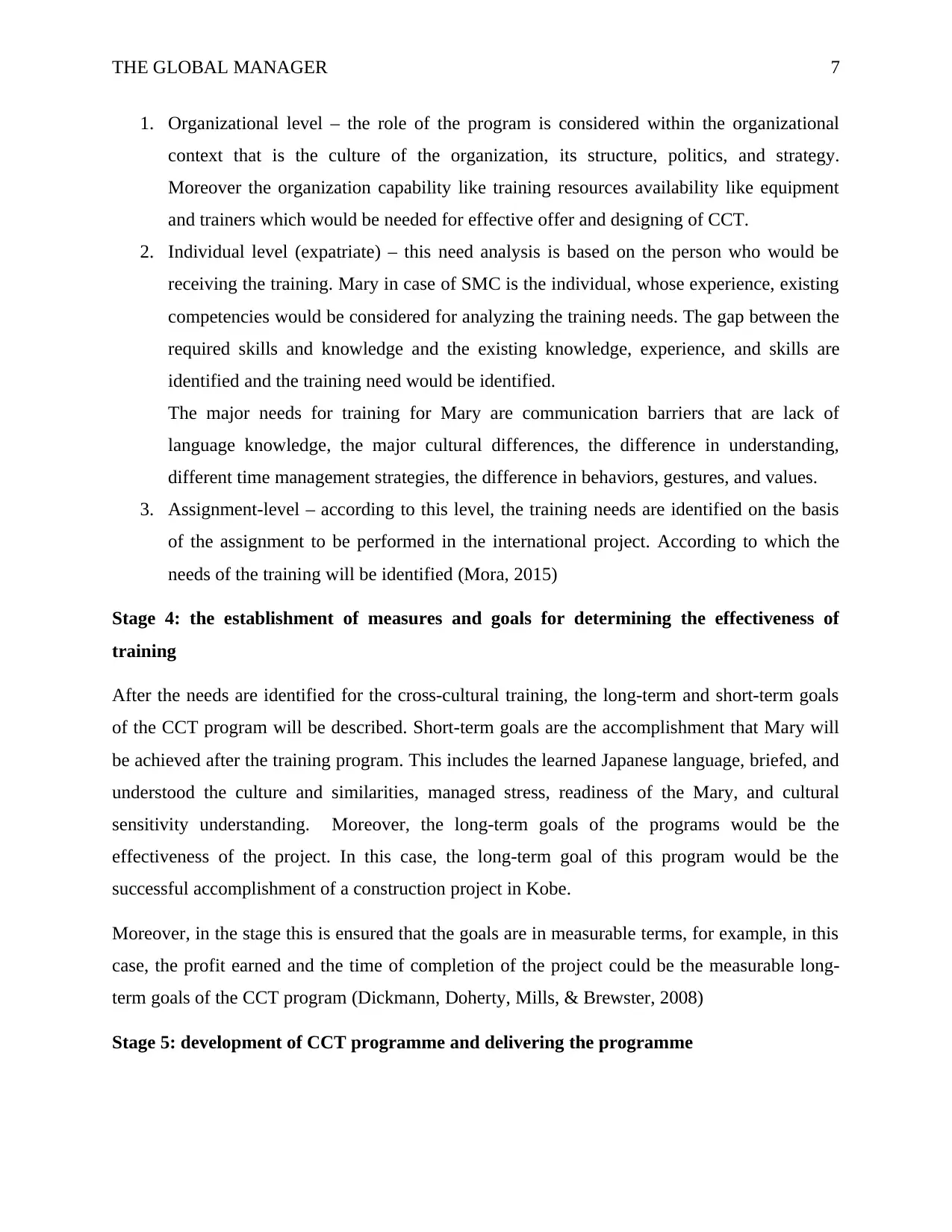
THE GLOBAL MANAGER 7
1. Organizational level – the role of the program is considered within the organizational
context that is the culture of the organization, its structure, politics, and strategy.
Moreover the organization capability like training resources availability like equipment
and trainers which would be needed for effective offer and designing of CCT.
2. Individual level (expatriate) – this need analysis is based on the person who would be
receiving the training. Mary in case of SMC is the individual, whose experience, existing
competencies would be considered for analyzing the training needs. The gap between the
required skills and knowledge and the existing knowledge, experience, and skills are
identified and the training need would be identified.
The major needs for training for Mary are communication barriers that are lack of
language knowledge, the major cultural differences, the difference in understanding,
different time management strategies, the difference in behaviors, gestures, and values.
3. Assignment-level – according to this level, the training needs are identified on the basis
of the assignment to be performed in the international project. According to which the
needs of the training will be identified (Mora, 2015)
Stage 4: the establishment of measures and goals for determining the effectiveness of
training
After the needs are identified for the cross-cultural training, the long-term and short-term goals
of the CCT program will be described. Short-term goals are the accomplishment that Mary will
be achieved after the training program. This includes the learned Japanese language, briefed, and
understood the culture and similarities, managed stress, readiness of the Mary, and cultural
sensitivity understanding. Moreover, the long-term goals of the programs would be the
effectiveness of the project. In this case, the long-term goal of this program would be the
successful accomplishment of a construction project in Kobe.
Moreover, in the stage this is ensured that the goals are in measurable terms, for example, in this
case, the profit earned and the time of completion of the project could be the measurable long-
term goals of the CCT program (Dickmann, Doherty, Mills, & Brewster, 2008)
Stage 5: development of CCT programme and delivering the programme
1. Organizational level – the role of the program is considered within the organizational
context that is the culture of the organization, its structure, politics, and strategy.
Moreover the organization capability like training resources availability like equipment
and trainers which would be needed for effective offer and designing of CCT.
2. Individual level (expatriate) – this need analysis is based on the person who would be
receiving the training. Mary in case of SMC is the individual, whose experience, existing
competencies would be considered for analyzing the training needs. The gap between the
required skills and knowledge and the existing knowledge, experience, and skills are
identified and the training need would be identified.
The major needs for training for Mary are communication barriers that are lack of
language knowledge, the major cultural differences, the difference in understanding,
different time management strategies, the difference in behaviors, gestures, and values.
3. Assignment-level – according to this level, the training needs are identified on the basis
of the assignment to be performed in the international project. According to which the
needs of the training will be identified (Mora, 2015)
Stage 4: the establishment of measures and goals for determining the effectiveness of
training
After the needs are identified for the cross-cultural training, the long-term and short-term goals
of the CCT program will be described. Short-term goals are the accomplishment that Mary will
be achieved after the training program. This includes the learned Japanese language, briefed, and
understood the culture and similarities, managed stress, readiness of the Mary, and cultural
sensitivity understanding. Moreover, the long-term goals of the programs would be the
effectiveness of the project. In this case, the long-term goal of this program would be the
successful accomplishment of a construction project in Kobe.
Moreover, in the stage this is ensured that the goals are in measurable terms, for example, in this
case, the profit earned and the time of completion of the project could be the measurable long-
term goals of the CCT program (Dickmann, Doherty, Mills, & Brewster, 2008)
Stage 5: development of CCT programme and delivering the programme
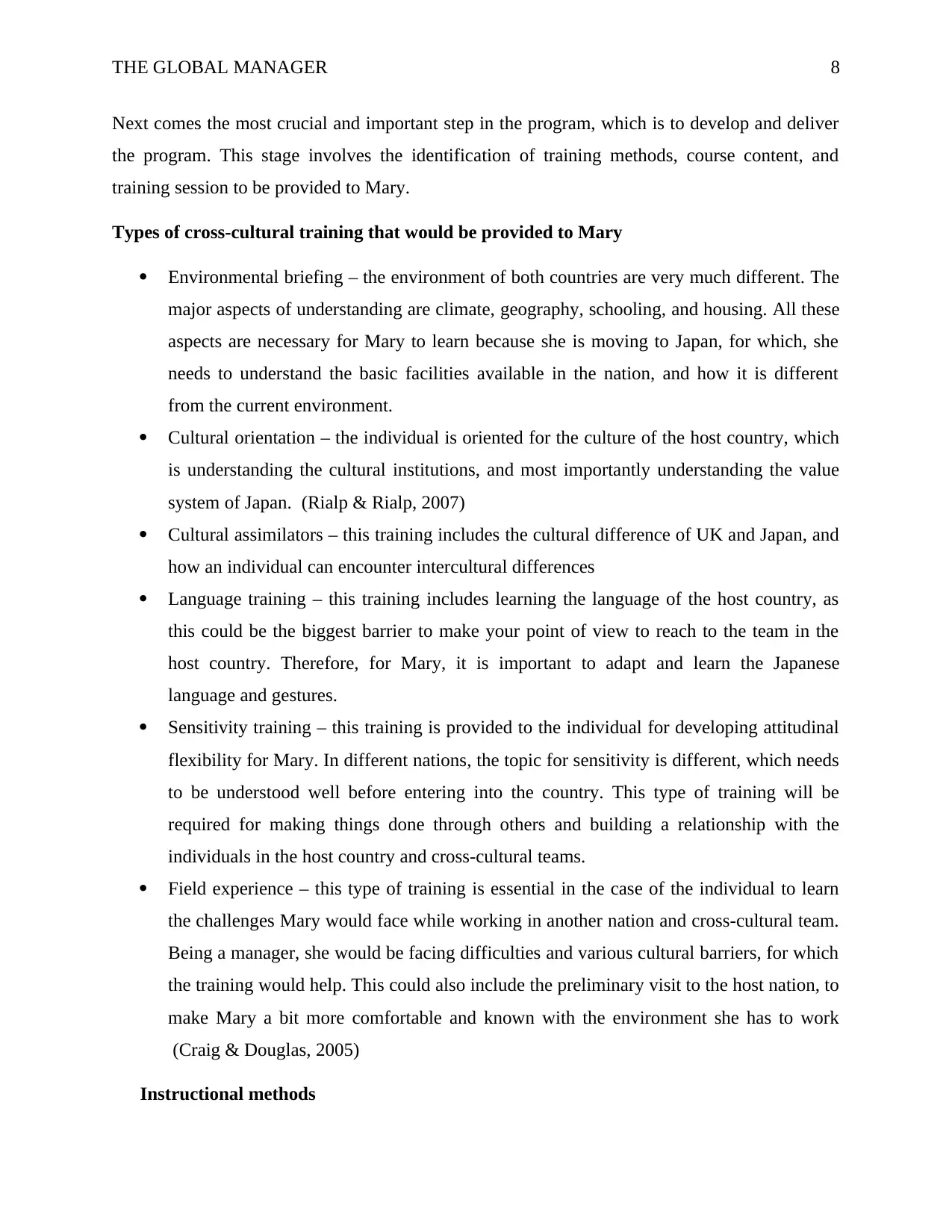
THE GLOBAL MANAGER 8
Next comes the most crucial and important step in the program, which is to develop and deliver
the program. This stage involves the identification of training methods, course content, and
training session to be provided to Mary.
Types of cross-cultural training that would be provided to Mary
Environmental briefing – the environment of both countries are very much different. The
major aspects of understanding are climate, geography, schooling, and housing. All these
aspects are necessary for Mary to learn because she is moving to Japan, for which, she
needs to understand the basic facilities available in the nation, and how it is different
from the current environment.
Cultural orientation – the individual is oriented for the culture of the host country, which
is understanding the cultural institutions, and most importantly understanding the value
system of Japan. (Rialp & Rialp, 2007)
Cultural assimilators – this training includes the cultural difference of UK and Japan, and
how an individual can encounter intercultural differences
Language training – this training includes learning the language of the host country, as
this could be the biggest barrier to make your point of view to reach to the team in the
host country. Therefore, for Mary, it is important to adapt and learn the Japanese
language and gestures.
Sensitivity training – this training is provided to the individual for developing attitudinal
flexibility for Mary. In different nations, the topic for sensitivity is different, which needs
to be understood well before entering into the country. This type of training will be
required for making things done through others and building a relationship with the
individuals in the host country and cross-cultural teams.
Field experience – this type of training is essential in the case of the individual to learn
the challenges Mary would face while working in another nation and cross-cultural team.
Being a manager, she would be facing difficulties and various cultural barriers, for which
the training would help. This could also include the preliminary visit to the host nation, to
make Mary a bit more comfortable and known with the environment she has to work
(Craig & Douglas, 2005)
Instructional methods
Next comes the most crucial and important step in the program, which is to develop and deliver
the program. This stage involves the identification of training methods, course content, and
training session to be provided to Mary.
Types of cross-cultural training that would be provided to Mary
Environmental briefing – the environment of both countries are very much different. The
major aspects of understanding are climate, geography, schooling, and housing. All these
aspects are necessary for Mary to learn because she is moving to Japan, for which, she
needs to understand the basic facilities available in the nation, and how it is different
from the current environment.
Cultural orientation – the individual is oriented for the culture of the host country, which
is understanding the cultural institutions, and most importantly understanding the value
system of Japan. (Rialp & Rialp, 2007)
Cultural assimilators – this training includes the cultural difference of UK and Japan, and
how an individual can encounter intercultural differences
Language training – this training includes learning the language of the host country, as
this could be the biggest barrier to make your point of view to reach to the team in the
host country. Therefore, for Mary, it is important to adapt and learn the Japanese
language and gestures.
Sensitivity training – this training is provided to the individual for developing attitudinal
flexibility for Mary. In different nations, the topic for sensitivity is different, which needs
to be understood well before entering into the country. This type of training will be
required for making things done through others and building a relationship with the
individuals in the host country and cross-cultural teams.
Field experience – this type of training is essential in the case of the individual to learn
the challenges Mary would face while working in another nation and cross-cultural team.
Being a manager, she would be facing difficulties and various cultural barriers, for which
the training would help. This could also include the preliminary visit to the host nation, to
make Mary a bit more comfortable and known with the environment she has to work
(Craig & Douglas, 2005)
Instructional methods
⊘ This is a preview!⊘
Do you want full access?
Subscribe today to unlock all pages.

Trusted by 1+ million students worldwide
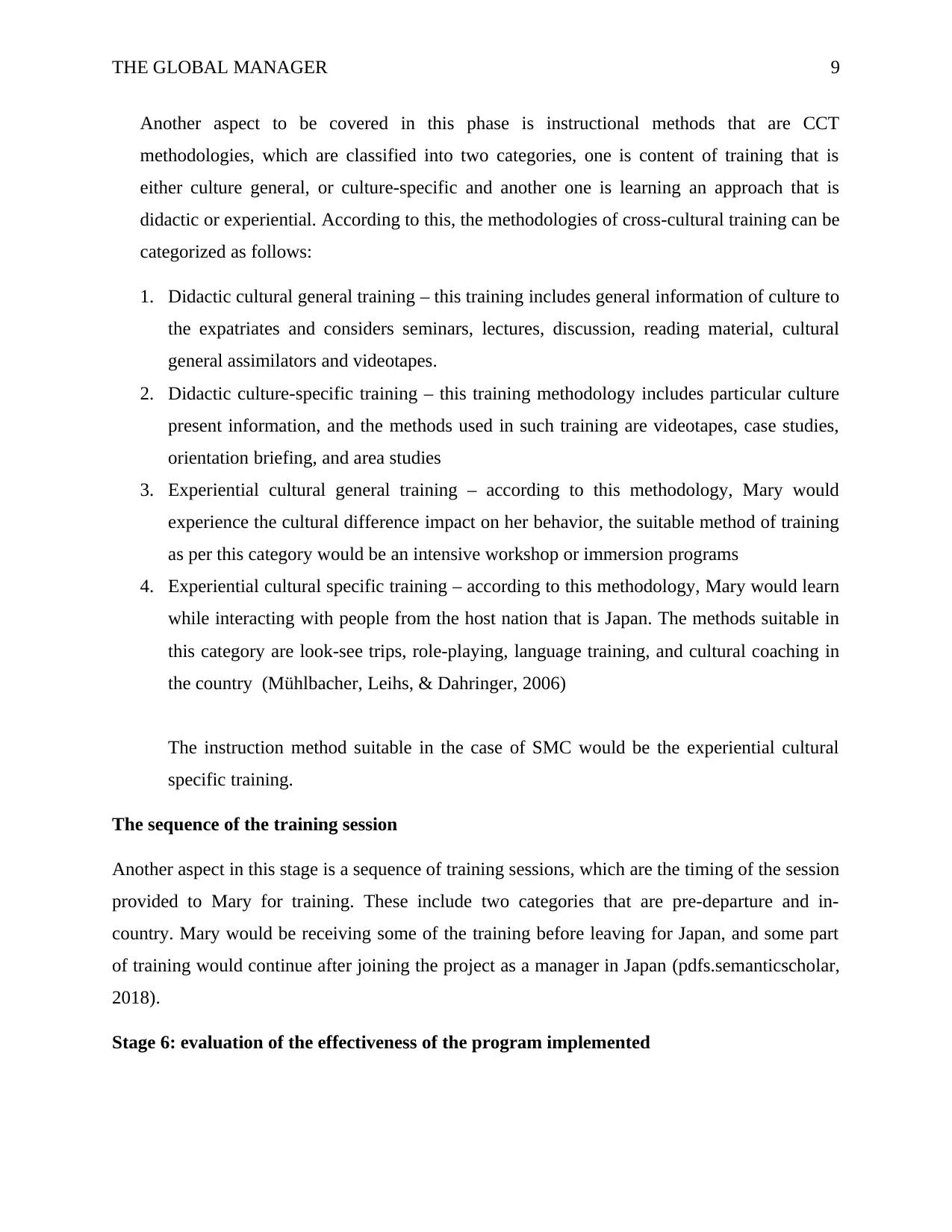
THE GLOBAL MANAGER 9
Another aspect to be covered in this phase is instructional methods that are CCT
methodologies, which are classified into two categories, one is content of training that is
either culture general, or culture-specific and another one is learning an approach that is
didactic or experiential. According to this, the methodologies of cross-cultural training can be
categorized as follows:
1. Didactic cultural general training – this training includes general information of culture to
the expatriates and considers seminars, lectures, discussion, reading material, cultural
general assimilators and videotapes.
2. Didactic culture-specific training – this training methodology includes particular culture
present information, and the methods used in such training are videotapes, case studies,
orientation briefing, and area studies
3. Experiential cultural general training – according to this methodology, Mary would
experience the cultural difference impact on her behavior, the suitable method of training
as per this category would be an intensive workshop or immersion programs
4. Experiential cultural specific training – according to this methodology, Mary would learn
while interacting with people from the host nation that is Japan. The methods suitable in
this category are look-see trips, role-playing, language training, and cultural coaching in
the country (Mühlbacher, Leihs, & Dahringer, 2006)
The instruction method suitable in the case of SMC would be the experiential cultural
specific training.
The sequence of the training session
Another aspect in this stage is a sequence of training sessions, which are the timing of the session
provided to Mary for training. These include two categories that are pre-departure and in-
country. Mary would be receiving some of the training before leaving for Japan, and some part
of training would continue after joining the project as a manager in Japan (pdfs.semanticscholar,
2018).
Stage 6: evaluation of the effectiveness of the program implemented
Another aspect to be covered in this phase is instructional methods that are CCT
methodologies, which are classified into two categories, one is content of training that is
either culture general, or culture-specific and another one is learning an approach that is
didactic or experiential. According to this, the methodologies of cross-cultural training can be
categorized as follows:
1. Didactic cultural general training – this training includes general information of culture to
the expatriates and considers seminars, lectures, discussion, reading material, cultural
general assimilators and videotapes.
2. Didactic culture-specific training – this training methodology includes particular culture
present information, and the methods used in such training are videotapes, case studies,
orientation briefing, and area studies
3. Experiential cultural general training – according to this methodology, Mary would
experience the cultural difference impact on her behavior, the suitable method of training
as per this category would be an intensive workshop or immersion programs
4. Experiential cultural specific training – according to this methodology, Mary would learn
while interacting with people from the host nation that is Japan. The methods suitable in
this category are look-see trips, role-playing, language training, and cultural coaching in
the country (Mühlbacher, Leihs, & Dahringer, 2006)
The instruction method suitable in the case of SMC would be the experiential cultural
specific training.
The sequence of the training session
Another aspect in this stage is a sequence of training sessions, which are the timing of the session
provided to Mary for training. These include two categories that are pre-departure and in-
country. Mary would be receiving some of the training before leaving for Japan, and some part
of training would continue after joining the project as a manager in Japan (pdfs.semanticscholar,
2018).
Stage 6: evaluation of the effectiveness of the program implemented
Paraphrase This Document
Need a fresh take? Get an instant paraphrase of this document with our AI Paraphraser
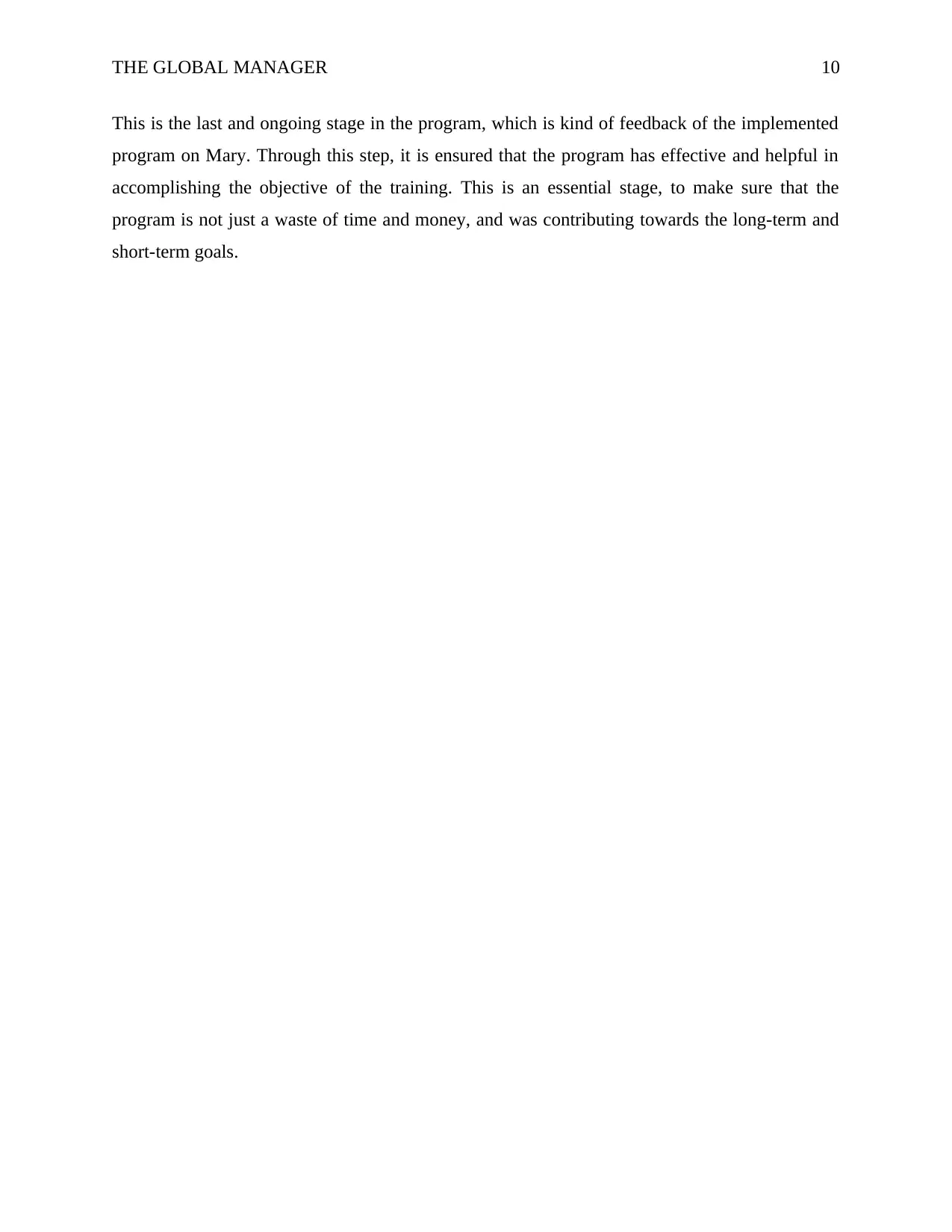
THE GLOBAL MANAGER 10
This is the last and ongoing stage in the program, which is kind of feedback of the implemented
program on Mary. Through this step, it is ensured that the program has effective and helpful in
accomplishing the objective of the training. This is an essential stage, to make sure that the
program is not just a waste of time and money, and was contributing towards the long-term and
short-term goals.
This is the last and ongoing stage in the program, which is kind of feedback of the implemented
program on Mary. Through this step, it is ensured that the program has effective and helpful in
accomplishing the objective of the training. This is an essential stage, to make sure that the
program is not just a waste of time and money, and was contributing towards the long-term and
short-term goals.
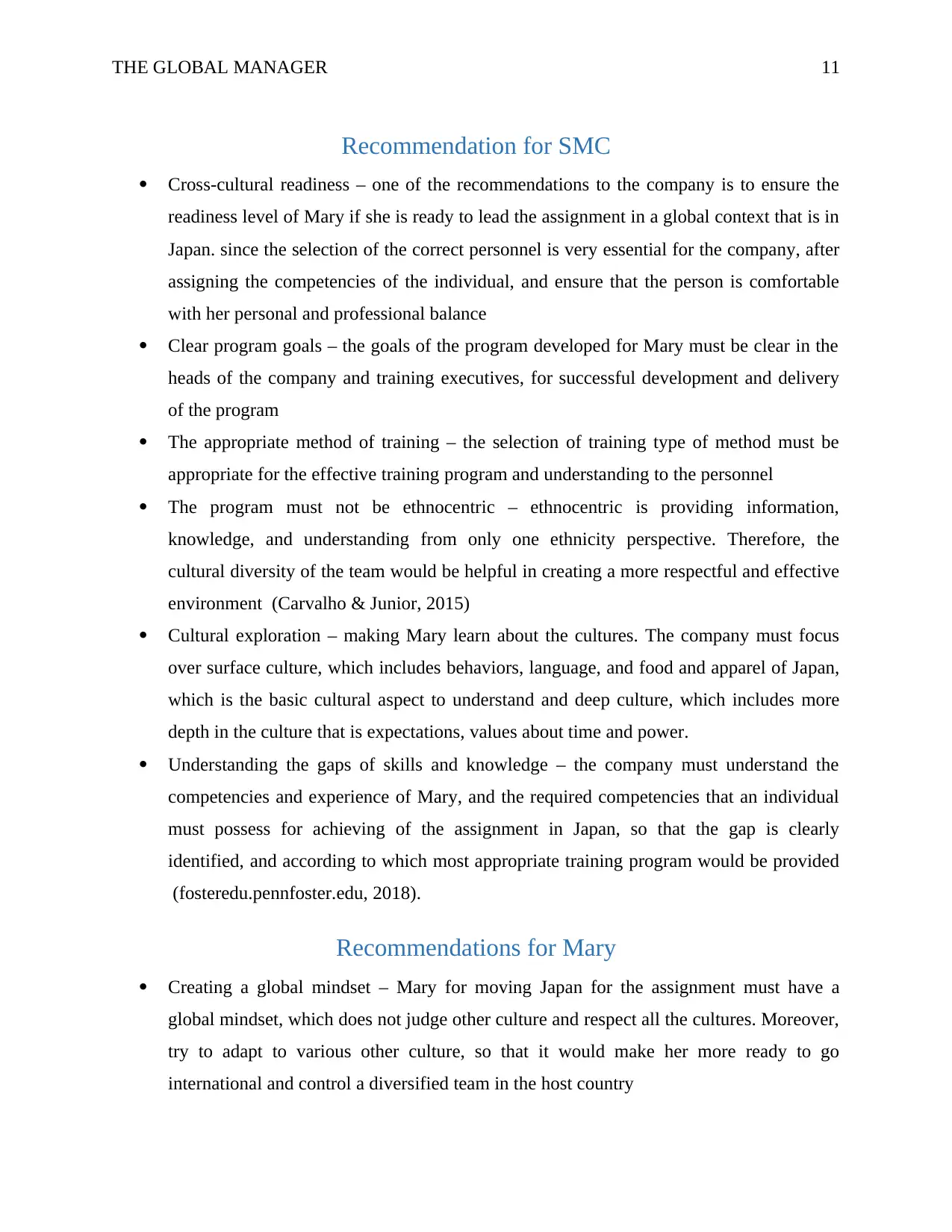
THE GLOBAL MANAGER 11
Recommendation for SMC
Cross-cultural readiness – one of the recommendations to the company is to ensure the
readiness level of Mary if she is ready to lead the assignment in a global context that is in
Japan. since the selection of the correct personnel is very essential for the company, after
assigning the competencies of the individual, and ensure that the person is comfortable
with her personal and professional balance
Clear program goals – the goals of the program developed for Mary must be clear in the
heads of the company and training executives, for successful development and delivery
of the program
The appropriate method of training – the selection of training type of method must be
appropriate for the effective training program and understanding to the personnel
The program must not be ethnocentric – ethnocentric is providing information,
knowledge, and understanding from only one ethnicity perspective. Therefore, the
cultural diversity of the team would be helpful in creating a more respectful and effective
environment (Carvalho & Junior, 2015)
Cultural exploration – making Mary learn about the cultures. The company must focus
over surface culture, which includes behaviors, language, and food and apparel of Japan,
which is the basic cultural aspect to understand and deep culture, which includes more
depth in the culture that is expectations, values about time and power.
Understanding the gaps of skills and knowledge – the company must understand the
competencies and experience of Mary, and the required competencies that an individual
must possess for achieving of the assignment in Japan, so that the gap is clearly
identified, and according to which most appropriate training program would be provided
(fosteredu.pennfoster.edu, 2018).
Recommendations for Mary
Creating a global mindset – Mary for moving Japan for the assignment must have a
global mindset, which does not judge other culture and respect all the cultures. Moreover,
try to adapt to various other culture, so that it would make her more ready to go
international and control a diversified team in the host country
Recommendation for SMC
Cross-cultural readiness – one of the recommendations to the company is to ensure the
readiness level of Mary if she is ready to lead the assignment in a global context that is in
Japan. since the selection of the correct personnel is very essential for the company, after
assigning the competencies of the individual, and ensure that the person is comfortable
with her personal and professional balance
Clear program goals – the goals of the program developed for Mary must be clear in the
heads of the company and training executives, for successful development and delivery
of the program
The appropriate method of training – the selection of training type of method must be
appropriate for the effective training program and understanding to the personnel
The program must not be ethnocentric – ethnocentric is providing information,
knowledge, and understanding from only one ethnicity perspective. Therefore, the
cultural diversity of the team would be helpful in creating a more respectful and effective
environment (Carvalho & Junior, 2015)
Cultural exploration – making Mary learn about the cultures. The company must focus
over surface culture, which includes behaviors, language, and food and apparel of Japan,
which is the basic cultural aspect to understand and deep culture, which includes more
depth in the culture that is expectations, values about time and power.
Understanding the gaps of skills and knowledge – the company must understand the
competencies and experience of Mary, and the required competencies that an individual
must possess for achieving of the assignment in Japan, so that the gap is clearly
identified, and according to which most appropriate training program would be provided
(fosteredu.pennfoster.edu, 2018).
Recommendations for Mary
Creating a global mindset – Mary for moving Japan for the assignment must have a
global mindset, which does not judge other culture and respect all the cultures. Moreover,
try to adapt to various other culture, so that it would make her more ready to go
international and control a diversified team in the host country
⊘ This is a preview!⊘
Do you want full access?
Subscribe today to unlock all pages.

Trusted by 1+ million students worldwide
1 out of 18
Related Documents
Your All-in-One AI-Powered Toolkit for Academic Success.
+13062052269
info@desklib.com
Available 24*7 on WhatsApp / Email
![[object Object]](/_next/static/media/star-bottom.7253800d.svg)
Unlock your academic potential
Copyright © 2020–2025 A2Z Services. All Rights Reserved. Developed and managed by ZUCOL.





